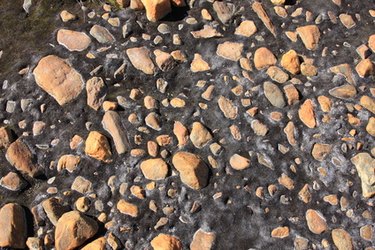
Healthy soils rely on water, oxygen, air and a balanced supply of nutrients. Chemical reactions within the soil can alter the physical structure of available nutrients. Oxidation and reduction processes involve the oxygen exchanges that take place between water and inorganic materials. These changes affect available nutrient supplies.
Identification
Video of the Day
Soil materials are made up of individual atoms and molecules that combine to form organic and inorganic matter. When combined with water, oxygen and each other, these materials can alter one another's molecular structures, according to Virginia Tech. Atoms and molecules are made up of protons, neutrons and electrons, so alterations in structure typically result in changes to the number of electrons a particular atom has. Oxidation and reduction in soils involve the exchange of electrons that takes place between soil materials.
Video of the Day
Function
According to Virginia Tech, oxidation and reduction processes occur simultaneously as one material or element loses electrons while another one gains what was lost. As a result, these processes are called redox reactions since one reaction cannot occur without another. In effect, the oxidation portion carries out half of the reaction while the reduction portion carries out the other half, which makes each portion of the process a half reaction. As materials lose and gain electrons, they can behave differently because their physical structures have been altered.
Oxidation and Reduction
The chemical reactions that take place in the soil depend on the physical makeup of each material. According to Chemguide, when an oxidation reaction occurs, one material is considered the oxidizing agent while the other becomes the reducing agent. Oxidation involves a loss of electrons, so an oxidizing agent or material will lose electrons to another material. The material that receives the electrons becomes the reducing agent because it reduces the number of electrons the other material has. The presence of oxygen and water in the soil can increase the likelihood of a redox reaction, depending on the physical makeup of the soil's materials.
Standard Reduction Potential
According to Virginia Tech, the amount of available electrons in the soil can determine the likelihood of redox reactions. Conditions like high water content or water-logged soil can contribute to the number of available electrons. The Standard Reduction Potential, or Eh value, indicates the rate at which electron exchanges take place in the soil. High Eh values mean a large number of electrons are present, whereas a low Eh value indicates a low number. Dry soils typically carry a low Eh value. This measurement can help determine whether a particular soil environment can hold onto its nutrient materials.
Considerations
As materials become oxidized (gain electrons), they acquire a charge that can eventually degrade a material's structural composition, according to Virginia Tech. This can be a good thing or a bad thing, depending on what materials are degraded. Redox reactions can be used to eliminate organic or inorganic pollutants when soil elements are properly matched to cause the oxidation of pollutant materials. In terms of nutrient depletion in soils, saturated or water-logged conditions can cause existing microbe materials to deplete soil nutrients, as these organisms feed on available oxygen. When no oxygen is available, microbes will engage in reduction reactions with whatever materials are available.